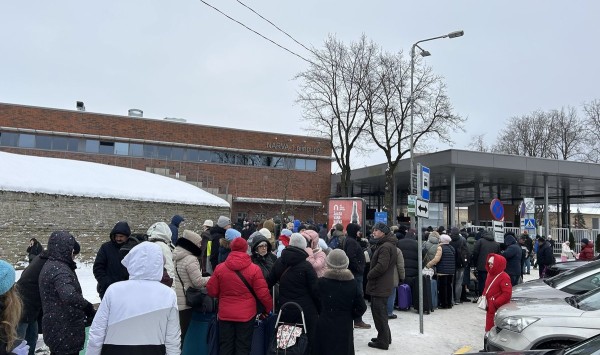
As part of the ceremony at Linda Hall south of Stettler, Otto Nicklom raises the Estonian flag. It's three colours, blue, black and white, symbolize sky, earth and soul.
STETTLER - Estonian President Lennart Meri's indelible footprints have generated new meaning for descendants of pioneers who fled the Crimea in the early 1900s.
During a visit to the Linda Hall District south of Stettler in July 2000, Meri challenged Canadian Estonians to work harder at preserving the culture and history they share.
They took it to heart.
Five years later, members of the Estonian clans from throughout Alberta have formed a provincial federation dedicated to meeting Meri's challenge. The Alberta Estonian Heritage Society, established last November, held its first Jaanipaev at Linda Hall on Saturday.
The celebration of summer solstice, including traditional music and games, brought together the descendants of Estonians who arrived at Sylvan Lake between 1899 and 1903, after receiving favourable reports from a scouting party.
Not only did they come from the same country, they were part of the same community," said AEHS president Bob Tipman.
Members of the community had moved en masse into the Crimea during the late part of the 19th century, following up on promises of free land from the Russian government. They arrived to an area of unproductive soil and a government in turmoil. Their history in the Crimea is rife with accounts of torture and deprivation suffered at the hands of Russian nationals.
The Kingsep brothers, Hendrik and Kristjan, decided to explore opportunities in Canada, setting up homesteads in 1899 at Sylvan Lake. The reports they sent back encouraged about 25 more families to follow their lead and set up homesteads in Central and Southern Alberta. Some families, including the Mottuses, the Koots and the Postis, found land north of Eckville that closely resembled the land they had farmed at home. A few moved to the Barons district, near Lethbridge.
Others moved to the area south of Stettler. While the Linda Hall district was quite different than Eckville, the new arrivals liked the idea of being able to move into a large block of land where they could all be close together, said Tipman.
The Stettler group named their new community centre after their patron saint Linda, wife of Kalen, an Estonian national hero.
Allan Posti, whose grandfather arrived in 1902, said he can attest to the similarity in landscape between Eckville and Estonia.
I know that for a fact because I've been there."
Posti has visited his grandfather's homeland three times since 1992, when Estonia won independence from the crumbling Soviet Union.
He said he has found a world of difference" since his first visit and his most recent. They're ahead of us in many ways, like Internet banking and cellphone usage. Cellphones are cheaper than landlines. It's no problem to go to a store, buy a cellphone and stop at a service station or news kiosk to buy air time."
The Soviets had failed in their attempt to erase Estonia's history and language, said Posti. Today, Russians who wish to remain in Estonia are required to learn the language and take part in the culture their government tried to hard to destroy.
Tipman said that at the time of Meri's visit to Canada, the Estonian descendants had established a number of small culture societies throughout Alberta, including branches in Edmonton and Calgary. Individually, they were finding they did not have enough people to keep the memories alive.
Together, he said, they are making it happen. The AEHS is now a growing organization with 150 registered members provincewide.


















